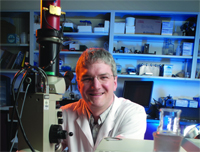
Food CSIs
November 6, 2007
By Barbara Lauer
Solving the edible “whodunit”
 The city isn’t glittering like Vegas, nor littered with half-naked bodies of nubile young women, as is Miami, and their lab isn’t spacious and backlit like that of CSI New York, but the work that the Laboratory Services Division of the University of Guelph conducts in food forensics is just as serious. They look for foreign matter in food, determine what it is, how it got there, what the danger is … and who or what is responsible. And, just like the guys on TV, Andrew Moore and his team always get their man, woman or microbe.
The city isn’t glittering like Vegas, nor littered with half-naked bodies of nubile young women, as is Miami, and their lab isn’t spacious and backlit like that of CSI New York, but the work that the Laboratory Services Division of the University of Guelph conducts in food forensics is just as serious. They look for foreign matter in food, determine what it is, how it got there, what the danger is … and who or what is responsible. And, just like the guys on TV, Andrew Moore and his team always get their man, woman or microbe.
“Anything and everything comes to us,” says Moore, B.Sc., M.Sc., head of the Forensic Food Lab, unique to Canada, which has been solving contaminant/foreign object cases for 10 years. He and his staff have specialized training and expertise to solve product quality issues resulting from food and production contaminants. Submissions to the lab range from defects and contaminants discovered by in-house quality assurance programs, to customer complaints, to the deliberate adulteration of food products.
“The demand for our services has grown over the years,” says Moore, “which reflects industry’s concern for food safety and the public’s as well.” Forensic science is the application of a broad spectrum of sciences, which, when combined, can provide pertinent information and answer questions for a crime science investigation.
“Most of the contamination with baked goods is after it’s produced,” says Moore, “from the consumer’s home. For instance, a glass is broken, pieces go flying and one lands on the baked good. The consumer calls the company and the company sends us the product to determine if the glass contamination came from within or without the company. It’s critical knowledge – without it, the company wouldn’t know whether to recall a batch of baked goods or not. Or, whether a consumer was mistaken in their assumption about their product.”
“We’ve dealt with in-store tampering, such as needles shoved into packages,” says Moore. “But, they’ve been sewing needles, or staples or pins, not hypos.”
The lab uses microscopy and spectroscopy systems to detect what elements are, then try to match the compounds using infrared x-ray. Sometimes, it takes common sense and patience to continue searching until the element can be identified.
“Mixtures of compounds can be impossible to identify,” says Moore. “But we can tell the company what it isn’t – so the company can rule out equipment failure.
“We’ll get a bun with grey dust on top of it. Using the spectrophotometer (SEM) we can zoom in and identify the streaks, which are often grease from equipment, and the SEM will also identify the type of metal in the grease,” says Moore.
Often, the food forensics lab receives dental amalgam (fillings) that consumers try to pass off on companies as coming from their products. Using an X-ray microscope, the material is easily identified – and the source, which is an outside contaminant. Blood is also commonly investigated, when consumers mistake the caramelization from baking on a bun. Moore uses the kits seen on TV CSI shows to test for blood, to determine if it’s human or animal – if it’s blood at all.
“If we need to see inside an object, such as a virus or a pest that was found in the product,” says Moore, “we take a very thin slice of it and use the Transmission Electron Microscope (TEM) to shoot electrons through it. This will tell us whether it was from the company’s plan or the consumer’s backyard.”
In addition to food contaminants, Moore and his colleagues also test for food allergens, which are potentially life-threatening to consumers. The food forensics lab has an extensive collection of databases and reference materials, which is a key element in its accurate and timely identification process.
You won’t see Andrew or any of his team on the big screen any time soon, but many of the companies in our industry have already, and will continue to benefit from the food forensic lab’s successful resolution of customer complaints, quality defects and potential litigation. With several million dollars worth of leading edge equipment and a track record for solving some of the country’s trickiest food mysteries, these are the go-to guys for any edible “whodunit.”
Print this page
Leave a Reply